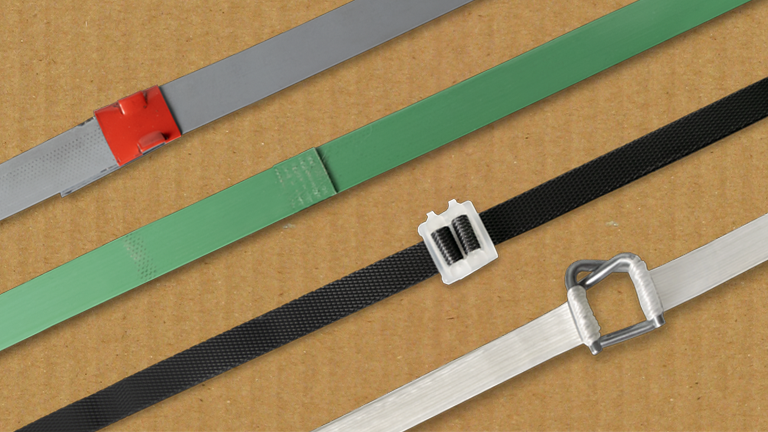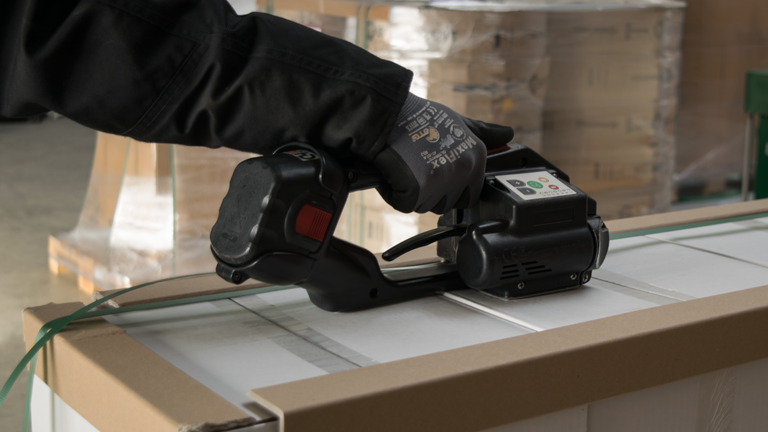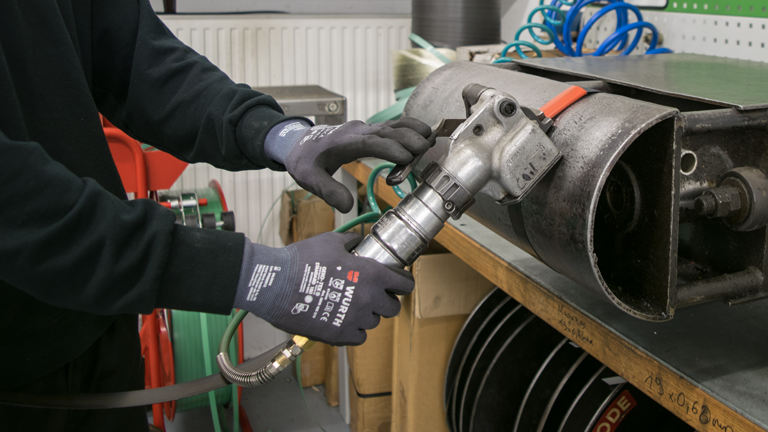Strapping is the process of securing packages with the help of sealing tape. The aim is to prevent loads from slipping, shifting or tipping during transport. In addition, it is suitable for bundling individual goods together so that the transport and loading of goods is simplified.
What does it depend on? - The selection of the suitable strapping

The uses of strapping are many and varied. This makes it all the more important for you to be aware of the requirements for the correct strapping of your goods. Strapping is available in different materials and designs depending on the intended use. In the following, we will take a closer look at the different types of strapping. Important factors that play a role in the selection are:
- Nature and type of goods
- Transport duration
- Weather conditions to which the package is exposed
- Weight of the package
- Temperature during the strapping process
An overview of different types of strapping bands
PP strapping:
PP strapping is particularly suitable for goods that are only light to medium in weight. The abbreviation PP in the name stands for polypropylene and provides information about the material used. The strapping is available in various colours, the standard version being black. PP tape is suitable for bundling goods and packages, for additional carton sealing or securing light pallet loads.
The strap is available in various thicknesses and strap widths and can bear a breaking load of up to 480 kg, depending on the grade. PP strapping can be processed and sealed either manually with the help of sealing buckles, with manual strapping tools or with semi- or fully automatic strapping machines. Due to the material properties of PP strapping, the tension decreases progressively, which is why it is only suitable for use when the transport routes are rather short and there is no permanent stress on the securing.
Polypropylene strapping is particularly inexpensive to purchase and offers an efficient way of securing loads due to the possibility of machine use.
PET strapping:
PET strapping is ideal for securing goods that are heavier in weight. The material used for the securing aid is polyethylene terephthalate (PET). The tensile strength of this material is much higher and, due to its higher breaking load, it can withstand loads of up to 1700 kg.

Due to the higher load capacity, the tension losses during the strapping process are also lower. Longer transport distances are therefore no problem and can be covered without further ado. The strapping can be carried out by hand, but in practice it has proven to be more efficient if the strapping is carried out with the PET strapping, partially or fully automatically. Due to stretching effects during the strapping process, the PET strapping yields and stretches between 12 and 25% depending on the quality. This makes it particularly suitable for goods that shrink after strapping (for example, damp wood before drying). The securing effect is further enhanced by this.
The PET strap is convincing because it is suitable for heavy packaging and has a high tensile and breaking load. In addition, it can be processed mechanically. PET strapping is mainly used for securing pallets and offers a modern alternative to steel strapping in many cases.
Steel strapping:
Steel strapping is particularly suitable when it comes to transporting and securing especially heavy and/or sharp-edged goods. Compared to all types of strapping, steel strapping, with a breaking load of up to 3000kg, is able to absorb the largest forces. Even withstanding extreme weather conditions or extreme stress due to temperature fluctuations is no problem - there is only a very slight loss of tension, which does not represent a safety risk. Furthermore, steel products that are still in the cooling process can be strapped without any problems. Due to the extremely high tensioning capacity, steel strapping is mostly carried out with pneumatic tensioning devices.

The biggest advantage of steel strapping is that it can be used for heavy goods and loads. There is no relaxation of tension so that the goods are not subject to fluctuations during transport. A disadvantage in this context is that steel strapping is considerably more expensive to purchase than PP strapping and PET strapping. Furthermore, there is a risk of injury, especially when reopening the closed strapping.
Textile strapping:
Textile strapping, also known as polyester thread strapping, is made of polyester filament yarn and is ideal for sensitive surfaces in particular. The particularly soft surface of the packaging aid protects packaged goods from damage in particular. The tensile strength is particularly high with a breaking load of up to 2000 kg - the tension loss is comparatively low. The textile strapping is applied manually or with pneumatic tensioning devices. Wire buckles are used as the closure, which keep the strapping closed thanks to their ingenious design.
Textile strapping is particularly convincing because it can be used for heavy loads and is gentle on the surfaces of the goods being transported. The ability to be retightened as well as the flexibility and ease of processing during strapping make textile strapping a popular aid. A disadvantage, however, is that it is not possible to process the strap with machines. Manual sealing by attaching sealing mechanisms takes time and is rather disadvantageous in practice. In addition, sharp-edged goods are excluded from use.
Conclusion - countless possibilities
There are various possibilities for securing loads - other options are available for every need. Therefore, in terms of safety, it should always be carefully weighed up whether the chosen aid meets the requirements of the load and whether optimal load securing can be guaranteed in this way. Only the right choice of material and tensioning devices will result in proper load securing during the transport of goods. Therefore, choose carefully and always pay close attention to the manufacturer's specifications!
You are unsure in view of the flood of information and have questions regarding the correct selection of the right strapping system? Do not hesitate and contact us. We will be happy to advise and help you.